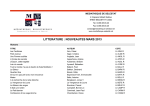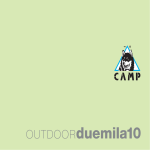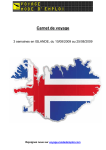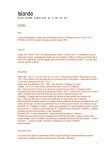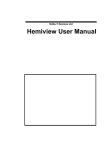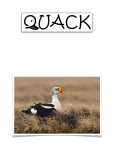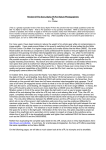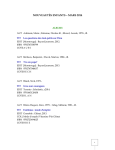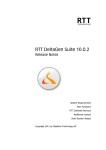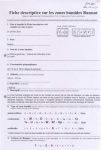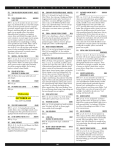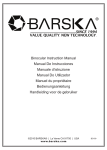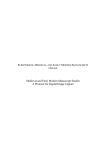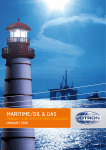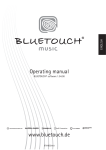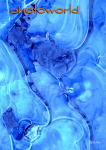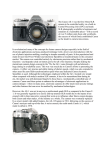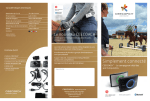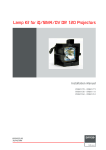Download Quack Summer 2015
Transcript
Summer 2015 - Vol. 13, Issue 3 All contents © 2015 E.J. Peiker Welcome to the quarterly newsletter from E.J. Peiker, Nature Photographer and www.EJPhoto.com. In this quarterly publication, I share with fellow photographers my photographic experiences, photo equipment reviews, photo and processing tips, and industry news. I also inform subscribers about upcoming workshops and products that I offer. Please feel free to forward this to other photographers and interested parties but please do so only by forwarding this newsletter in its entirety. All content is copyrighted by E.J. Peiker and may not be reproduced. If you would like to be added to the mailing list, unsubscribe, or access back issues, please visit: www.ejphoto.com/newsletter.htm Godafoss, Iceland (Nikon D810, 25mm) Northern Iceland In Late Spring I have just returned from my 9th visit to Iceland where I led NatureScape.net's first workshop into Northern Iceland with long time friend and Iceland resident Johann Oli Hilmarsson, Iceland's leading bird expert. From our initial scouting expedition to the north it took nearly two years of organization and planning with NSN's excellent team to pull this off and it went very well even though it started off somewhat disastrous when my luggage didn't arrive and prior to leaving there was the threat of massive nationwide strikes threatening to shut down much of the travel infrastructure in Iceland. Fortunately the strike tensions eased just as we were departing for Iceland and my luggage arrived about a day and a half after I did and caught up with me literally two minutes before heading to the more remote parts of the country. We started our journey on the day of arrival with a drive through the Reykjanes Peninsula in southwestern Iceland to keep people awake and adjusted to the local time zone. We visited a geothermal area and some sea stacks to get the juices flowing. Without my clothes, due to the baggage delay, it became very obvious very quickly that temperatures were way below normal. Despite it being a sunny day, temperatures were only in the 30's (all temps in Fahrenheit) with a strong wind knocking the wind chill factor well below freezing. This is 25-30 degrees below normal for this time of year. After a much needed night's sleep we headed off to Reykjavik's Tjornin, a lake in the center of town which can be very good for waterfowl and gulls in Winter and Spring. Upon our arrival, we were immediately treated with point blank photo opportunities for Common Eider in pristine breeding plumage. With a little more work and patience we also got great shots of Tufted Duck, Black-headed Gull, Lesser Blackbacked Gull, Great Black-backed Gull, and Whooper Swan. There were even flight shot opportunities of the very handsome Black-headed Gull. Two minutes before our bus left for points north, my baggage arrived Common Eider (D7200, 80-400mm) providing me a huge sense of relief and a quick donning of some warmer clothes. After lunch we started our journey towards the north where we photographed the spectacular Hraunfossar. This is a 1 kilometer long band of waterfalls that flow out of the side of a cliff fed by glacial water running through underground lava tubes and then dumping into a river. Unfortunately the country side was much browner than expected for this time of year since temperatures have been very cold all spring. In fact, May was the coldest month of May since 1979 in Iceland and the third coldest in recorded history. But it was sunny which brings out the beautiful blues of the glacial water. On Day 3, after a pre-breakfast exploration around the historic village of Reykholt, we drove all the way to Myvatn in the northeast stopping along the way to photograph a waterfowl species that was missing from my project to photograph all species of waterfowl in the world. I was elated to see and photograph Pinkfooted Goose - a rather shy species. It took quite a bit of sneaking up to and hiding from the birds behind natural terrain but I did get some successful shots. Closer to our destination of Myvatn, we also stopped at the incredible Godafoss and photographed it in challenging, but rewarding light. By early evening we arrived at Myvatn, our base of operation for the next few days. After dinner, those that weren't too worn out from the long day's travel headed out for more waterfowl photography in the Myvatn area and it's a good thing we did because the weather was to get much worse over the next couple of days. During this shoot I got the other waterfowl species that I had targeted for this trip and was missing from my files, the super skittish Common Scoter. I was also able to set-up a nice shoot of a spectacularly plumed Horned Grebe for those still shooting around 11:00PM. Pink-footed Goose (D7200, 500mm, 1.4x) On morning 3, as the weather started clouding over, we headed out early to photograph Harlequin Ducks and Barrows Goldeneye before conditions deteriorated too much and had great success. That evening we drove farther east and North to visit the insanely powerful Sellfoss and Dettifoss, the latter of which is the most powerful waterfall in all of Europe. While conditions weren't ideal due to wind and rain, it was great to see these falls again and to see the stark contrast between the lush green landscape around Dettifoss a couple of years ago and the heavy snow and ice cover this year. Weather turned to snow and sleet on the 4th day but not before we visited one of the larger geothermal areas in Iceland to the east of Myvatn and photographed this alien landscape that is a cross between what I imagine Venus and Mars are. In the afternoon we visited the large power plant east of Myvatn in a blizzard but had fun taking "industrial" style photos. That evening in somewhat improving conditions we photographed more Horned Grebes on Myvatn, Europe's largest waterfowl breeding lake. The 5th day was largely a travel day as we worked our way toward the northwest. After a leisurely stop in the northern port city of Akureyri we visited the Hvitserkur sea stack formation that looks like an ancient Mastodon and then on to our hotel for a nice dinner. Dettifoss (D810, 50mm) The next morning, on Day 6, the weather started to get very nice, although still very cold, and we made it all the way to the Puffin Cliffs of Lautrabjarg. On the way, we stopped at an old shipwreck where among other things, we were able to photograph Eurasian Oystercatchers in flight. At Latrabjarg, we had great light three nights in a row for some excellent Puffin photography along with Razorbill, Kittiwake and Northern Fulmar. We also visited the beach where the shore bird shooting of Ringed Plover and breeding plumage Sanderling could not have been better. On day 8 we visited the Dymjandi waterfall complex for a few hours of shooting these exceptional and numerous waterfalls. We were even treated to some rainbows in our photos from the falls. After three evening puffin shoots, on Day 9 it was time to move on and we made our way, via Ferry to the ever popular Flatey Island in the middle of Breidafjordur where we spent the day photographing culture, birds and landscapes. An evening ferry then brought us to the Snaefellsnes Peninsula. The next day we explored this western peninsula visiting classic locations such as Kirkjufellsfoss, Arnarstapi, and Malarif. The next day we returned to Reykjavik in a rain and sleet storm where we had a very nice farewell dinner. For the trip We observed or photographed a record 66 species of birds! The camaraderie of this group was second to none and despite the weather never even getting to 40 degrees, we had a great time and came away with lots of great photos. Namafjal Hverir (D810, 21mm) New Flagship Cameras by Canon, Sony, and Phase One The last quarter brought us the announcement of three new flagship cameras. None of these are actually shipping at the time of publication but there is lots of information available to make some initial assertions. Canon EOS 5Ds and 5DsR: The EOS 5Ds and 5DsR are two cameras that are identical in every way except for the final filter on top of the sensor stack. The EOS 5Ds twins feature an EOS 5D Mk III body with the EOS 7D Mark II sensor scaled up to full frame proportions with elimination of the dual pixel on sensor AF points resulting in 50 megapixels, a new record for the 35mm format. The 5Ds has a standard anti-aliasing filter to virtually eliminate the possibility of moiré pattern interference when shooting subjects with very fine repeating patterns. The 5DsR adds a cancellation filter behind the AA filter to try to reduce the blurring effect of the filter and increase resolution slightly. It is interesting to see Canon go down the same path that Nikon did with the D800 and D800E and not incorporate the learning from their chief competitor which resulted in the D810 which eliminated the AA filter completely. Canon did this to not have to make minor sensor to mount distance differences between the two cameras in production. Additional improvements include new dual image processors and it inherits the 61 point autofocus system and metering system from the 7d Mk II. A nice addition is the inclusion of some crop modes including Canon's classic APS-H or 1.3x mode and their 1.6x APS-C like mode. These two modes result in approximately 30 megapixels and 20 megapixels each. It should be noted that when shooting in the 1.6crop mode, the camera basically becomes an EOS 7D Mk II minus the super fast frame rate - everything else should be virtually identical including image quality. Frame rate is 5 FPS in all modes. ISO is capped at just 6400 in normal modes and 12,800 in expanded modes. Canon has added USB 3 to the camera but has removed the clean HDMI out option for video shooters making it not suitable for serious video production. The EOS 5D Mk III continues to be a superior camera for that. While this will propel Canon into the lead in pixel count for a 35mm format camera it does nothing to further Canon's Achilles heel. Dynamic range continues to be about 2 stops behind the competition due to several choices that Canon makes in its sensor design and manufacturing process which other sensor manufacturers do not. Canon continues to use what is now nearly 10 year old semiconductor technology resulting in less light collection per pixel and off sensor A/D conversion. The combination of these two keeps these cameras from being all that they can be on the dynamic range front. From a resolution standpoint though, large photos I have seen taken with these cameras have a very impressive amount of fine detail. Acuity of fine detail in the distance is not in medium format territory but is still excellent. Phase One XF: Every time I have shot with Phase One cameras over the last few years I come away thrilled with the images but somewhat frustrated by the shooting experience. The Phase One system, which consists of three primary modules - lens, camera, and digital back - produces what is arguably the best image quality in the world. The digital sensor and the Schneider Kreuznach Leaf Shutter lenses are superb but the Mamiya 645 derived Phase One 645 DF+ body is a late 1990's body that is badly out of date and a kluged camera to sort-of work the digital world. Multiple lock-ups, the camera losing its mind, utterly worthless autofocus, a different battery in the camera than in the data back, needing to power up both the back and body separately, constantly having to reset the system, and so on were simply not worthy of the sensor and lenses and absolutely not something one expects from a system that can run close to $100,000 for a complete kit with several lenses. For years now, whenever talking to people at Phase One and telling them there is no way that I would invest in a system where the camera body is simply incapable of providing a good shooting experience, they would say "it is coming" - and we waited and waited and waited... Finally on June 2, 2015, Phase One made good on its promise and introduced the XF - a new body that brings the system largely up to date and introduces some very innovative technology. The new camera body, which can mate with the previous IQ1 and IQ2 digital backs as well as the new fully integrated (electronically speaking) IQ3 backs has a completely redesigned and modernized AF module although, disappointingly, it is still a single center point. The user interface is now fully programmable and even the top LCD can be operated via a touch screen and gestures or it can be operated via traditional buttons. There are three user configurable mechanical dials that can be set to shutter speed, aperture, and ISO or other functions if you desire. The viewfinder, which was already excellent from a brightness and image size standpoint has been improved significantly and is now even brighter. A new waist level viewfinder is also available and the two can be switched back and forth at will essentially making this now a 4 piece modular system: lens, body, viewfinder, digital back. Price is still in the stratosphere. I priced out a basic landscape kit using the cheapest of the IQ3 databacks, the cropped sensor 50 megapixel IQ350 and lenses covering from wide to short telephoto and it still came out to over $70,000, although if you can buy it in Euros you save over 10% as Phase One is using a $1.30/euro exchange rate rather than the current $1.10/euro exchange rate. The other drawback is the weight. The camera and digital back weigh more than a whole Sony a7R II (see below) kit with complete 16-200mm focal length range and 42 megapixels which isn't all that different from 50 megapixels. But oh that fine detail and image quality... Sony a7R II: After months of anticipation, Sony has finally announced the a7R II. Highlights of the camera include a new back-side illuminated (BSI) 42 megapixel sensor, In-body image stabilization, 399 on sensor phase-detection autofocus points, largest image size viewfinder in a 35mm format camera, fully electronic shutter capability, 5 frames per second in all AF modes, and 4K video (full frame and Super 35). It also adopts the improved ergonomics of the 24 megapixel a7 II along with the weight gain of the a7 II. By using BSI sensor technology, nearly 100% of the surface of the sensor can be used for light collection since all electronics are below the light collection wells that make up the pixels. This allows an increase in megapixels without the commonly associated reduction in dynamic range or increase in noise. In fact the a7R II has better noise than the a7R despite the slight increase in megapixels. Let's look at my issues with the original a7r, which I still use as my primary landscape camera when weight is an issue, and see what has been addressed since I first wrote my extensive review in early 2014: Poor Battery Life: This still plagues this system and most mirrorless cameras, with a CIPA rating of only 290 shots on a battery, this issue remains unresolved. In-camera only charging: Unless you buy a separate charger, Sony still is too cheap to include a charger for their batteries in a $3200 camera! The issue is unresolved but is easily resolved with a cheap external charger. Poor documentation: At this writing, it appears that Sony will again ship the camera without a complete detailed user's manual, just a useless quick-start guide. Unresolved! Power On Time too long: This was significantly improved on the original a7R with multiple firmware upgrades. It still takes a long time to power up Sony mirrorless cameras after a battery change. Whether or not this is still the case with the a7R2 remains to be seen. For now, this issue is mostly resolved. Poor AF performance: The new AF system resolves this issue. Furthermore, AF with Canon lenses and a fully electronic adapter is excellent compared to the old camera. Object tracking is much better and the frame rate does not drop in continuous autofocus mode. The issue I had with the minimum AF spot size being too big has also been addressed. AF performance is largely resolved with the a7R2. Poorly conceived menus: Completely unresolved! Sony's menus are an abomination. It can still take as many a 20 menu page scroll to go between related items - for example selecting frame size/ratio such as 16:9 is 20 menu pages away from selecting a reduced APS-C frame size. Unresolved. Handicapped Auto ISO and Auto Bracket: The auto ISO minimum shutter speed issue on the a7R has been resolved. The artificial restrictions in bracketing have also been eliminated You can now bracket 2, 3, 5, or 9 shots with exposures differences of up to 3 stops with 3 or 5 frames selected. Resolved! Lossy RAW Files: Sony continues to use a lossy compression algorithm that knocks it's 14 bit sensor output down with its RAW files despite repeated and brutal criticism from the entire photo world. It is almost incomprehensible that Sony hampers the image quality of its world leading sensors with a lossy compression scheme on its RAW files. Sony, you MUST stop cooking your RAW files now! Shutter button placed in an un-ergonomic position: Resolved with the redesign of the a7 Mark 2 camera and copied by the a7R Mark 2. Metering system biased toward under exposure: Sony protects the highlights with its metering system to an extreme level resulting in up to a stop under-exposure. Even its blinking highlights and zebras (set to 100% +) still leave about 2/3 of a stop on the table before the RAW file is blown. It is unknown at this time whether this is improved on the new camera. Exposure compensation dial can't be re-tasked. Unresolved USB 2 ports instead of USB 3 - the new camera still uses USB 2. Dumb move Sony - unresolved! Auto-white balance useless outside of a narrow range (similar to other manufacturers). Unknown if this is resolved but this is an issue with all digital cameras on the market. Other quibbles include a significant increase in weight over the a7R, no dual card slots, no user definable menu, and a hefty 30% price increase to $3200 for the body. The Sony a7r II definitely ups the ante in mirrorless cameras with its 42 megapixel BSI sensor which retains the same excellent dynamic range as its predecessor. It also addresses some of the biggest issues the original camera had - shutter shock is eliminated with a newly designed shutter and a full electronic shutter option and the poor autofocus system is replaced with one that will perform dramatically better (we have already seen how good the new type of AF system can be on the a6000 and the a7r2's system is an enhancement of that). The relatively wobbly lens mount has been redesigned and made more rigid. It also comes in an all metal weather-sealed body. As is usually the case, not every complaint of the original a7R has been addressed but this promises to be an excellent upgrade that really propels this camera to the next level. If the RAW file compression issue were addressed, I could easily see this completely replacing my Nikon gear for landscape photography. It's Going To Get Even Tougher To Fly As A Bird/Wildlife Photographer Airline flying and bird photography are becoming more and more at odds with one another. While there has always been some friction in this area, it's about to get much worse I'm afraid. Airlines generate a lot of revenue by forcing you to check-in your luggage for the aircraft's cargo hold. If they can force more luggage into the cargo hold, they make more money so if they reduce what you can carry on-board, they make more money. Some airlines in the US are now not checking your oversized luggage that you Eurasian Oystercatcher (D7200, 80-400mm) show up at the gate with for free anymore. On some, if you show up to the gate with oversized luggage, they take it from you and charge you a fee. The fundamental issue is that bird/wildlife and sports photographers carry very large and heavy lenses and cameras that combined can cost as much as a nice car. Airlines want to continually squeeze more and more things onto planes and reduce the size and weight of what you can carry on. While European photographers have had to deal with ridiculously low cabin baggage restrictions for some time, the US has been largely immune to the size and weight restrictions but it has gotten harder over the years as airlines imposed fees for checked baggage but not carry-on cabin baggage. This has led to more and more people bringing larger and larger bags onboard and this has been largely unpoliced. If you are on a full flight, which most are these days in the age of matching capacity to demand with regard to flights, unless you are in the first 2/3 of passengers boarding the flight, you are likely to have your carry-on luggage taken from you since they have run out of overhead space. If you have ever watched how this luggage is handled after it is taken from you, you will not want to allow that to happen to your equipment. It is not unusual for all of the gate-checked luggage to be thrown off of the jetway onto the ground. Depending on the type of aircraft, this can be as much as 3 stories. Photographers that travel a lot try to maintain status with the airlines they travel on the most so that they always get early boarding slots or pay for economy plus or even business class in order to avoid this. If that isn't possible, they make sure they get on as early as possible when their boarding zone is called. We have developed a lot of ways to get our stuff on board under our own control the whole time. We have also figured out which airlines to avoid and how to spot agents that are militant about policing your baggage vs. those that are more understanding and we have largely gotten by. In recent times, new methods to increase the amount of baggage revenue generated and the number of bags that can get on a plane so that everyone gets an opportunity for carry-on baggage regardless of their place in the boarding queue are being proposed and in some cases adopted. Just recently the International Air Transport Association (which has a goal of increasing revenue for the airlines, among other things) has issued new recommendations for maximum carry-on size limitations that are significantly smaller than before, especially in thickness. A 600mm f/4 lens would be too wide to go onboard as a carry-on inside any luggage with its lens hood attached (in reverse) on airlines that adopt the new standard. Much of our "airline approved" camera baggage is now too big. Redesigned luggage fitting the new size standard has about 20% less volume than what the four major US carriers currently allow. So far no US carriers have adopted the recommendation and push back by US carriers has caused IATA to back-peddle a bit on this but many international carriers including Lufthansa, Emirates, Air China, Avianca, Cathay Pacific, and Qatar have adopted the standard. Additionally, some European carriers have adopted enforced carry-on weight limits of just 11 and 17 pounds. Can the US be far behind? Delta is piloting a program, if adopted system-wide, could remove you from control of your carry-on bag. This summer, on selected flights, Delta plans to pre-load your carry-on bags for you. It is voluntary but it is not beyond reason to think that they will load the stuff more efficiently into the overheads resulting in more bags being able to go on the plane and making this method compulsory at some point. And if it does become the policy, you can be sure that carry-on weight limitations will be enforced which are currently completely unenforced in the USA. One can only hope that the lens manufacturers will wake-up and start making f/5.6 super teles. Lenses like the Sigma 150-600 Sport might just be the ticket for future airline travel. Due to its f/6.3 maximum aperture lenses like this aren't nearly as wide across the front element and still good performance at the large aperture end of the lens range especially on cropped bodies. (Note: this lens in Nikon mount just arrived as I was publishing this newsletter. Look for a review soon) It is clear that traveling with our large and expensive super teles is not going to get easier and significant challenges lie ahead. At least for the time being, things are still OK in the USA but if traveling outside the US, even though foreign carriers often provide better in-flight service on newer planes, it is advisable, if possible, to Nikon 600 f/4 vs. Sigma 15-600 Sport Size Comparison book your flight on a US carrier. The question is, when will it simply become impossible to travel with a 400mm f/2.8, 500mm f/4, 600mm f/4 or 800m f/5.6 super-telephoto lens and a couple of heavy bodies. How Safe Are Your Image Files When You Travel? Many years ago now on the return from my first trip to Iceland, I nearly lost all of my photos I took on that trip. Back then I used the method that many photographers still use today. I had enough flash cards for maybe 4 or 5 days of shooting. Every day after getting done with photography, I would copy the files to the hard drive on my laptop and then back them up to a hard drive. So I came home with two complete copies of the photos and one partial copy - the computer's HD, the external HD, and whatever was on the CF cards that hadn't been overwritten. On the return from Iceland on Iceland Air into Boston Logan airport's international terminal I got on the shuttle bus to the domestic terminal that US Airways operated out of on the opposite side of the airport. When I got off the shuttle I took my large duffel and camera roller but left my computer bag on the shuttle. This computer bag contained my laptop with all copies of the images I took on that trip plus my back-up hard drive and my flash card wallet. All copies of my images were suddenly on the shuttle bus and not with me. I chased after the bus and fortunately the bus driver saw me and stopped. If he had not, my only recourse would have been to wait and check every bus until the bus came around and hope to get everything back. This could also potentially result in missing the flight home which I would gladly do to get my images back. This event changed how I do things when I travel as it pertains to my photograph's safety. As I lead tours to far away destinations I see many people doing the same thing I did and this puts their images at risk due to single points of failure. A single point of failure is when, despite having backups, a single event can render them all gone. In my case it was that I packed them all in a single piece of luggage. Even though it was hand luggage, losing it, having it stolen, or an accident can render all copies useless and your images can be gone and a trip of a lifetime ruined. Today I carry enough flash cards to last the entire trip without ever having to reuse one. This is the first and original copy of my images. I still backup to my computer's flash-based drive every night and make an external backup from that. Atlantic Puffin (D7200, 200mm) Today I use high capacity flash drives rather than failure prone external hard drives for my secondary back-up. These three copies are never packed in the same place and even during the day while out shooting, they are not left in the same place to protect them from fire, theft, earthquake, or whatever evils might become them... When I fly home, the computer is in my computer bag, the flash cards are in my camera bag, and the flash drives that have my third copy are in my pockets. This protects me from theft, airline loss, personal stupidity and more. Just like your backups at home, always evaluate and analyze your practices to avoid single points of failure that can render your images a total loss even when using a multiple backup strategy. The Best Lenses For Your Nikon and Canon Cameras Several readers requested that I add a second place lens since often the best lenses are prohibitively expensive. I have done that where I have enough data. Unfortunately in some cases the second place lens is as expensive or even more expensive but this is not true for all cases. Where there is a very large drop-off from the first place lens to the second place lens, I have added an asterisk (*). Additionally, I have picked up many new subscribers that are shooting with Sony a7 cameras. I have added a few new entries into the Sony E-mount column: Ringed Plover (D7200, 500mm, 1.4x) Lens Category Canon EF Mount Nikon F Mount Sony (F)E Mount Ultra Wide Prime Zeiss 15mm f/2.8 ZE Canon TS-E 17mm f/4 Zeiss 21mm f/2.8 ZE Canon 20mm f/2.8* Zeiss 25mm f/2 ZE Canon TS-E 24mm f/3.5L II Sigma 35mm f/1.4 Zeiss 35mm f/1.4 Distagon Zeiss 55mm f/1.4 Otus Sigma 50mm f/1.4 DG Art Zeiss 85mm f/1.4 Otus Canon 85mm f/1.2L II Zeiss 135mm f/2 Apo Sonnar ZE Canon 135mm f/2L Zeiss 15mm f/2.8 ZF.2 N/A Zeiss 21mm f/2.8 ZF.2 Nikon 20mm f/1.8* Zeiss 25mm f/2 ZF.2 Nikon 24mm f/1.4G* Sigma 35mm f/1.4 Zeiss 35mm f/1.4 Distagon Zeiss 55mm f/1.4 Otus Sigma 50mm f/1.4 DG Art Zeiss 85mm f/1.4 Otus Nikon 85mm f/1.8G Zeiss 135mm f/2 Apo Sonnar ZF.2 Sigma 150mm f/2.8 Macro OS Nikon 200mm f/2G Nikon Micro Nikkor 200mm f/4ED Nikon 300mm f/2.8G VR Nikon 400mm f/2.8G VR Nikon 500mm f/4G VR Nikon 600mm f/4G VR Nikon 800mm f/5.6E VR Nikon 14-24mm f/2.8G Tamron 15-30mm f/2.8 Di VC Tamron 24-70mm f/2.8 Di VC Nikon 24-70mm f/2.8G Nikon 70-200mm f/4G VR Nikon 70-200mm f/2.8L Nikon 80-400 f/4.5-5.6G VR Nikon 200-400mm f/4G VR II Nikon Micro Nikkor 200mm f/4ED N/A Extra Wide Prime Standard Wide Prime Moderate Wide Prime Standard Prime Portrait Prime (short telephoto) Medium Telephoto 200mm Prime Canon 200mm f/2L Canon 200mm f/2.8L II 300mm Prime 400mm Prime 500mm Prime 600mm Prime 800mm Prime Wide Angle Zoom Canon 300mm f/2.8L IS II Canon 400mm f/2.8L IS II Canon 500mm f/4L IS II Canon 600mm f/4L IS II Canon 800mm f/5.6L IS Canon 11-24mm f/4L Canon 16-35mm f/4L IS Canon 24-70mm f/2.8L II Tamron 24-70mm f/2.8 Di VC Canon 70-200mm f/2.8L IS II Canon 70-200mm f/4L IS Canon 200-400mm f/4L 1.4x Ext Canon 100-400 f/4.5-5.6 II* Sigma 150mm f/2.8 Macro OS Standard Zoom Telephoto Zoom Super Telephoto Zoom Long Macro Zeiss Batis 2/25 Zeiss Loxia 2/35 Sony-Zeiss 35mm F2.8 Sony-Zeiss 55mm f/1.8 Zeiss Loxia 2/50 Zeiss Batis 1.8/85 N/A N/A N/A N/A N/A N/A N/A Sony-Zeiss 16-35 f/4 Sony-Zeiss 24-70 f/4 Sony 70-200 f/4 G Upcoming Workshops I will again be offering my Phoenix Area Winter Duck Photography Workshop in January. This 3-day DuckShop™ will put you right where you need to be to walk away with breathtaking images of an array of ducks, waders and other species at some of the best winter hot spots in the U.S.! The Phoenix, Arizona area is a very popular winter home for many species of waterfowl and they’ll be all decked out in full breeding plumage! Possible species include Northern Pintail, American Wigeon, Ring-necked, Gadwall, Northern Shoveler, Canvasback, Lesser Scaup, Mallard, Green-winged Teal, Redhead Ducks and many other bird species. Find out more and/or sign up here: http://www.naturescapes.net/workshops/arizona_duckshop_2016 The NatureScapes team and I are currently working to put together another Northern Iceland Workshop for late May early June 2016. Additionally, look for a Costa Rica Landscapes workshop announcement with Greg Basco and me in Late June 2016. Private Photography Instruction and Consulting Services In addition to the duck photo workshops that I launched over 10 years, I also offer private instruction in Wildlife and Landscape photography at the place of your choosing within the USA and Canada. These private workshops are of the one on one variety (or two on one). Clients may schedule time in 4-hour time blocks for either classroom or field sessions. With just two people, a number of shooting locations become possible that aren’t possible for larger groups and thereby making it possible to photograph some species or locations that are not attainable with larger groups. More specific instruction, based on the client’s specific needs, can be given using this delivery method in either the classroom or in the field. For more information please see the following link: http://www.ejphoto.com/duckshop_private.htm I also offer both photo equipment and computer workstation/digital darkroom consulting services. This allows me to combine my 27 years of work in the computer industry with my lifetime of photographic experience and provide services at a technical level that are hard to find elsewhere. Contact me for rates and specifics or visit my rate sheet: http://www.ejphoto.com/Quack%20PDF/Rate%20Schedule%202014.pdf Photographic Services My list and rate table of photographic services can be found here: http://www.ejphoto.com/Quack%20PDF/Rate%20Schedule%202014.pdf Facebook Page http://www.facebook.com/pages/EJ-Peiker-Nature-Photographer/150804446733 Newsletter Info This is the 13th year of my quarterly Newsletter. I try to cover the wide array of digital imaging and products from mirrorless to medium format and everything in between. Throughout the years, the information contained herein has always been free and will continue to be free despite the many hours and significant equipment and travel expense it takes to put this together. Most of the products I have tested and reviewed, I have purchased myself; some have been made available to me for review and evaluation by loyal readers and a few have also been made available to me by the manufacturers themselves. While the newsletter is free either via eMail subscription or via accessing it on my website at http://www.ejphoto.com/newsletter.htm, if you find the information useful to you and you do wish to donate for my continuing efforts, you may do so via PayPal and sending the funds to [email protected]. Disclaimers E.J. Peiker conducts consulting services and product design services for a number of photographic product companies. Those that know me know I would not endorse a product even for compensation if I did not feel it were a superior product. E.J. Peiker writes for and is supported by Singh-Ray Filters and receives non-monetary compensation from Singh-Ray Filters. www.singh-ray.com E.J. Peiker is a Wimberley Professional Services featured photographer and receives non-monetary compensation from Wimberley. Visit Wimberley at www.tripodhead.com E.J. Peiker is a member of Nikon Professional Services and receives some services free of charge from Nikon USA www.nikonpro.com E.J. Peiker is a consultant for LensCoat and receives compensation for time spent working on LensCoat products. www.lenscoat.com E.J. Peiker is sponsored by Hunt's Photo and Video - New England's largest photography retailer. Visit them at www.huntsphotoandvideo.com/ E.J. Peiker is a co-founder of www.Naturescapes.net and leads photographic workshops under the NatureScapes Certified Workshops banner Legal Notice: Written and Photographic Content © E.J. Peiker, Nature Photographer. The text and photographs contained herein may not be copied or reproduced without written consent. This newsletter may be forwarded without restriction unaltered and in its entirety only. Sonoran Desert Preserve (D7100 720nm IR, 14-24mm)














